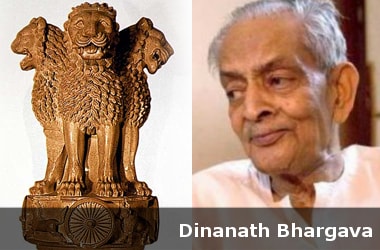
Globally renowned artist Dinanath Bhargava at the age of 89 passed away on 24th Dec, 2016
A native of Multai in Betul district of Madhya Pradesh, he designed the lion capitol in the national emblem along with 5 others.
He used to work in the All India Handloom Board and was posted in Indore. He was one of the exponents of Nandalal Bose of Shantiniketan. He is credited with wash paintings that created a niche in the art world.
He was credited with creating Madhubani paintings on cloth. Bhargava was also instrumental in double decker loom and designing new Chanderi saris.
He started the carpet-making industry in Gwalior during the time of late Congress leader Madhav Rao Scindia.
The Madhya Pradesh government honoured him for his contribution to the world of art.
His paintings were displayed in the Europe’s world art tour in the 1950’s, in which he won the gold medal.
Bhargava also decorated the pages of the Constitution's manuscript, died at the age of 89 in Indore yesterday.
He was suffering from cardiac ailments since past decade, family sources said.
Born on November 1, 1927 at Multai in Betul district of Madhya Pradesh, Mr Bhargava was chosen by noted painter Nandlal Bose (then the Principal of Kala Bhavan Shanti Niketan) in the group for designing the pages of the Indian Constitution's manuscript.
National Emblem of India- Adopted: 26th Jan, 1950.
- Motto: Satyameva Jayate (Truth Alone Triumphs)
- State Emblem is an adaptation of the Lion Capital of Ashoka at Sarnath, preserved in the Varanasi Sarnath Museum in India.
- The emblem forms a part of the official letterhead of the Government of India and appears on all Indian currency as well.
- The usage of the emblem is regulated and restricted under State Emblem of India (Prohibition of Improper Use) Act, 2005.
- सत्यमेव जयते (English: Truth Alone Triumphs) is a quote from Mundaka Upanishad, the conclusion of the Hindu Vedas.